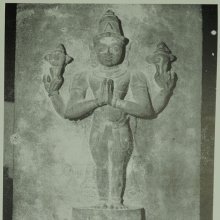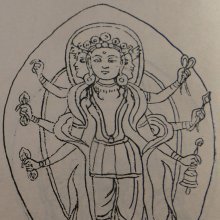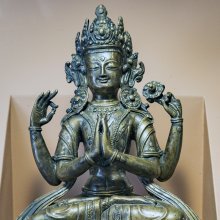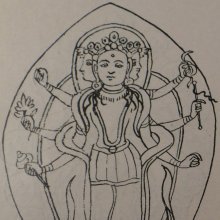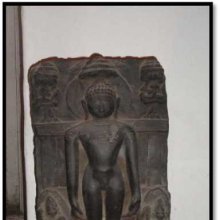Namaskara, Namaskāra: 19 definitions
Introduction:
Namaskara means something in Hinduism, Sanskrit, Marathi, Hindi. If you want to know the exact meaning, history, etymology or English translation of this term then check out the descriptions on this page. Add your comment or reference to a book if you want to contribute to this summary article.
Alternative spellings of this word include Namaskar.
Images (photo gallery)
(+4 more images available)
In Hinduism
Purana and Itihasa (epic history)
Source: archive.org: Shiva Purana - English TranslationNamaskāra (नमस्कार, “obeisance”) refers to “offering obeisance” and represents one of the sixteen upacāra, or “sixteen types of homage and services”, as described while explaining the mode of worshipping the phallic form (liṅga) of Śiva in the Śivapurāṇa 1.11. Accordingly, “[...] the devotee shall worship the mobile emblem with the sixteen types of homage and services (upacāra) as prescribed. It accords the region of Śiva gradually. The sixteen types of service are [for example, offering obeisance (namaskāra)] [...] Or he shall perform all the sixteen rites in the phallic emblem of human, saintly or godly origin, or in one naturally risen up (svayambhū) or in one of very extraordinary nature installed duly”.

The Purana (पुराण, purāṇas) refers to Sanskrit literature preserving ancient India’s vast cultural history, including historical legends, religious ceremonies, various arts and sciences. The eighteen mahapuranas total over 400,000 shlokas (metrical couplets) and date to at least several centuries BCE.
Shaktism (Shakta philosophy)
Source: Google Books: ManthanabhairavatantramNamaskāra (नमस्कार) refers to “salutations”, according to the Kularatnoddyota verse 2.21-27.—Accordingly, “[...] He worshipped the Great Transmission with hymns and excellent divine lauds, by exhibiting the Great Gestures and with salutations (namaskāra) and the waving of lamps along with divine words of praise and rites of adoration centered on the maṇḍala and the Krama. Taking up then the energizing (substances), O fair one, he who does all things, was conjoined with the goddess. O Supreme mistress, praised by the heroes, the Lord of the heroes and the universal Self took up the vessel with the meat and put it in (his) mouth along with the sacrificial pap. [...]”.

Shakta (शाक्त, śākta) or Shaktism (śāktism) represents a tradition of Hinduism where the Goddess (Devi) is revered and worshipped. Shakta literature includes a range of scriptures, including various Agamas and Tantras, although its roots may be traced back to the Vedas.
Ganapatya (worship of Ganesha)
Source: archive.org: Shiva Purana - (Ganesha)Namaskāra (नमस्कार) refers to “prostrations” (during the worship of Gaṇeśa), according to the Śivapurāṇa 2.4.18 (“Gaṇeśa crowned as the chief of Gaṇas”).—Accordingly, as Śiva said to Gaṇeśa: “[...] After prostrations (namaskāra), various routines shall be carried on. He who performs Vratas like this can secure the desired fruits. O Gaṇeśa, he who performs your worship upto his ability, with faith, shall derive the fruit of all desires. The devotee shall worship you, the lord of Gaṇas with vermillion, sandal paste, raw rice grains and Ketaka flowers as well as with other services. [...]”.
Ganapatya (गाणपत्य, gāṇapatya) represents a tradition of Hinduism where Ganesha is revered and worshipped as the prime deity (ishta-devata). Being a minor though influential movement, Ganapatya evovled, llike Shaktism and Shaivism, as a separate movement leaving behind a large body of literature.
General definition (in Hinduism)
Source: ACHC: Smarta PujaNamaskāra (नमस्कार) refers to “offering prostration”, representing one of the various services (upacāra) of a pūjā (ritualistic worship of a deity) which aim at the purification of the devotee.—The worshipper makes one or several prostrations (namaskāra) with (five, six or) eight limbs (cf. illustration), prostrates himself “like a stick” (daṇḍavat) on the ground or simply greets by joining both hands, a symbol of supplication. Salutation to one’s superior or to elders is believed to increase knowledge, span of life, fame and strength. The verse “namo ‘stu ... “ which is recited here is also found as the concluding verse of the Viṣṇusahasranāma in certain South Indian editions.
Languages of India and abroad
Marathi-English dictionary
Source: DDSA: The Molesworth Marathi and English DictionaryNamaḥkāra (नमःकार).—m Pronouncing the word namaḥ as at the time of casting the offering into the fire. Ex. namaḥ kārēṃsīṃ avadāna || mantrōccārēṃ ṭākīta ||.
Source: DDSA: The Molesworth Marathi and English Dictionarynamaskāra (नमस्कार).—m (S) namasyā f S Worship, obeisance, reverential or respectful address or salutation. It is performed by joining the palms, inclining the head, and pronouncing the word namaskāra. v kara, ghāla.
Source: DDSA: The Aryabhusan school dictionary, Marathi-Englishnamaskāra (नमस्कार).—m namasyā f Worship, obeisance.
Marathi is an Indo-European language having over 70 million native speakers people in (predominantly) Maharashtra India. Marathi, like many other Indo-Aryan languages, evolved from early forms of Prakrit, which itself is a subset of Sanskrit, one of the most ancient languages of the world.
Sanskrit dictionary
Source: DDSA: The practical Sanskrit-English dictionaryNamaḥkāra (नमःकार).—f.
Derivable forms: namaḥkāraḥ (नमःकारः).
Namaḥkāra is a Sanskrit compound consisting of the terms namas and kāra (कार). See also (synonyms): namaḥkṛti.
Source: Cologne Digital Sanskrit Dictionaries: Edgerton Buddhist Hybrid Sanskrit DictionaryNamaskara (नमस्कर).—nt., = °kāra (masc.), homage-paying: nidāna-namaskarāṇi samāptāni Mahāvastu i.2.12 (colophon).
Source: Cologne Digital Sanskrit Dictionaries: Shabda-Sagara Sanskrit-English DictionaryNamaskāra (नमस्कार).—m.
(-raḥ) 1. Respectful or reverential address or salutation. 2. A sort of poison. f. (-rī) A sensitive plant. E. namas bowing, and kāra making, fem. affix aca0 gaurā0 ṅīṣ; or namas + kṛ + ghañ .
Source: Cologne Digital Sanskrit Dictionaries: Benfey Sanskrit-English DictionaryNamaskāra (नमस्कार).—[namas-kāra], m. and nama- skriyā namas-kriyā, f. Adoration, [Nala] 5, 16; Mahābhārata 15, 954.
Source: Cologne Digital Sanskrit Dictionaries: Cappeller Sanskrit-English DictionaryNamaskāra (नमस्कार).—[masculine] exclamation of namas, worship, adoration.
Source: Cologne Digital Sanskrit Dictionaries: Monier-Williams Sanskrit-English Dictionary1) Namaḥkāra (नमःकार):—[=namas-kāra] [from namas > nam] m. the exclamation ‘namas’, adoration, homage, [Atharva-veda; Brāhmaṇa] etc.
2) [v.s. ...] a sort of poison, [cf. Lexicographers, esp. such as amarasiṃha, halāyudha, hemacandra, etc.]
Source: Cologne Digital Sanskrit Dictionaries: Yates Sanskrit-English DictionaryNamaskāra (नमस्कार):—[nama-skāra] (raḥ) 1. m. Respectful or reverential address. a. Sort of poison. f. (rī) Sensitive plant.
Source: DDSA: Paia-sadda-mahannavo; a comprehensive Prakrit Hindi dictionary (S)Namaskāra (नमस्कार) in the Sanskrit language is related to the Prakrit word: Ṇokkāra.
[Sanskrit to German]
Sanskrit, also spelled संस्कृतम् (saṃskṛtam), is an ancient language of India commonly seen as the grandmother of the Indo-European language family (even English!). Closely allied with Prakrit and Pali, Sanskrit is more exhaustive in both grammar and terms and has the most extensive collection of literature in the world, greatly surpassing its sister-languages Greek and Latin.
Hindi dictionary
Source: DDSA: A practical Hindi-English dictionaryNamaskāra (नमस्कार) [Also spelled namaskar]:—(nm) salutation, a term of greeting; adieu !, so long; —[karanā] to salute, to greet; to say good bye; •[, dūra se] keep away, not to have anything to do with.
...
Kannada-English dictionary
Source: Alar: Kannada-English corpusNamaskāra (ನಮಸ್ಕಾರ):—
1) [noun] a gesture of worship, obeisance, greeting, respect, etc. made by bending one’s head, prostrating oneself or joining both the palms with fingers, being closer to each other, pointing upward and thumb being closer to the breast.
2) [noun] a term used while greeting another respectfully.
3) [noun] the invocation, calling on a god, preceptor, saint, etc. by a poet, for blessing, inspiration, etc. at the beginning of a literary work.
4) [noun] ನಮಸ್ಕಾರ ಮಾಡು [namaskara madu] namaskāra māḍu = ನಮಸ್ಕರಿಸು [namaskarisu]; ನಮಸ್ಕಾರ ಹಾಕು [namaskara haku] namaskāra hāku = ನಮಸ್ಕರಿಸು [namaskarisu]; 2. to bid good-bye, farewell, adieu; 3. to abandon (a job, learning, etc.); ನಮಸ್ಕಾರ ಹೊಡೆ [namaskara hode] namaskāra hoḍe = ನಮಸ್ಕಾರ ಹಾಕು [namaskara haku].
Kannada is a Dravidian language (as opposed to the Indo-European language family) mainly spoken in the southwestern region of India.
See also (Relevant definitions)
Starts with: Namaskaram, Namaskaramgey, Namaskaramudra, Namaskaramudre, Namaskarana, Namaskaranamgey, Namaskaranem, Namaskarapakutam, Namaskarasahita, Namaskarastava, Namaskaravant, Namaskaravidhi.
Ends with: Anyataratonamaskara, Ashtanga-namaskara, Damdanamaskara, Gurupaddhatinamaskara, Hejjenamaskara, Nirnamaskara, Nirnamonamaskara, Pancamandalanamaskara, Pancanga-namaskara, Pradakshinanamaskara, Pratinamaskara, Rudranamaskara, Sashtamganamaskara, Shirasashtanganamaskara, Suryanamaskara, Tricakalpanamaskara, Ubhayatonamaskara, Uddamdanamaskara.
Full-text (+63): Nirnamaskara, Namaskriti, Namaskaram, Namaste, Namaskarana, Namaskaravant, Namahkaravat, Nirnamonamaskara, Namahkaravidhi, Namahkarastava, Suryanamaskara, Namaskarapakutam, Namahkari, Cashtankanamaskaram, Ubhayatonamahkara, Parshvanatha, Namasye, Sashtankanamaskaram, Namostu, Suryanamaskaravidhi.
Relevant text
Search found 38 books and stories containing Namaskara, Namahkara, Namaḥkāra, Namas-kāra, Namas-kara, Namaskāra; (plurals include: Namaskaras, Namahkaras, Namaḥkāras, kāras, karas, Namaskāras). You can also click to the full overview containing English textual excerpts. Below are direct links for the most relevant articles:
Chaitanya Bhagavata (by Bhumipati Dāsa)
Verse 3.8.152 < [Chapter 8 - Mahāprabhu’s Water Sports in Narendra- sarovara]
Verse 2.5.84 < [Chapter 5 - Lord Nityānanda’s Vyāsa-pūjā Ceremony and His Darśana of the Lord’s Six-armed Form]
Verse 3.3.403 < [Chapter 3 - Mahāprabhu’s Deliverance of Sarvabhauma, Exhibition of His Six-armed Form, and Journey to Bengal]
Trishashti Shalaka Purusha Caritra (by Helen M. Johnson)
Part 12: Story of the two bulls < [Chapter III - Mahāvīra’s first six years as an ascetic]
Part 7: The two physicians < [Chapter X - The recovery of draupadī]
Part 3: Incarnation of Sanatkumāra as Śakra < [Chapter VII - Sanatkumāracakricaritra]
The Skanda Purana (by G. V. Tagare)
Chapter 125 - The Greatness of Ravitīrtha (ravi-tīrtha) < [Section 3 - Revā-khaṇḍa]
Chapter 83 - Manifestation of Vīreśvara < [Section 2 - Uttarārdha]
Chapter 26 - Dialogue between King Cola and Viṣṇudāsa < [Section 4 - Kārttikamāsa-māhātmya]
The gods of northern Buddhism (by Alice Getty)
The Devi Bhagavata Purana (by Swami Vijñanananda)
The Indian Buddhist Iconography (by Benoytosh Bhattachacharyya)
Related products

